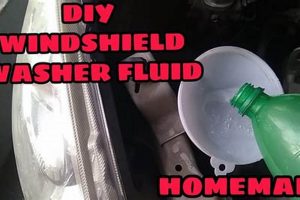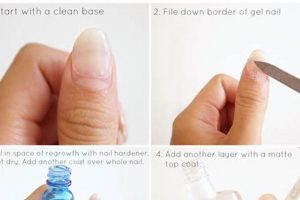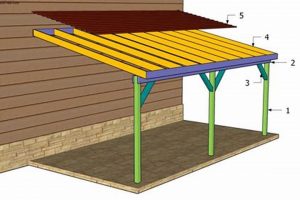The creation of decorative and functional items using clay and magnets presents a popular crafting activity. This involves shaping clay, often polymer or air-dry varieties, into desired forms, baking or drying it to harden, and then affixing magnets to the back. The resulting objects can be adhered to metallic surfaces such as refrigerators or whiteboards, serving both aesthetic and utilitarian purposes.
This form of handicraft offers a cost-effective and personalized approach to home decoration and gift-giving. The process encourages creativity and allows for the production of unique items tailored to individual preferences or specific themes. Historically, similar craft projects have provided avenues for self-expression and resourcefulness, utilizing readily available materials to create useful and visually appealing objects.
The following sections will explore the specific types of clay suitable for this craft, the necessary materials and tools, step-by-step instructions for crafting, and considerations for ensuring the magnets adhere securely for long-lasting results.
Essential Considerations for Clay and Magnet Integration
The subsequent information outlines critical points for achieving optimal results when combining clay artistry with magnetic functionality. These points are designed to enhance the durability and aesthetic appeal of finished pieces.
Tip 1: Clay Selection. Employ polymer clay for enhanced durability and water resistance. Air-dry clay, while convenient, exhibits greater fragility and susceptibility to moisture damage.
Tip 2: Magnet Strength. Neodymium magnets offer superior holding power compared to ceramic magnets. Select magnet size and strength appropriate to the weight and dimensions of the clay form.
Tip 3: Embedding Technique. Integrate the magnet within the clay structure prior to baking or drying, ensuring complete encapsulation for secure adhesion. Surface adhesion is less reliable.
Tip 4: Adhesive Reinforcement. If embedding is not feasible, utilize a strong adhesive such as epoxy resin to affix the magnet to the dried clay surface. Roughening the clay surface prior to application enhances bond strength.
Tip 5: Curing Time. Adhere strictly to the clay manufacturer’s recommended baking or drying times. Insufficient curing weakens the clay structure, increasing the risk of cracking or magnet detachment.
Tip 6: Sealing and Protection. Application of a sealant or varnish provides a protective layer against moisture and UV damage, extending the lifespan and preserving the visual appeal of the finished object.
Tip 7: Weight Distribution. Design the clay form to ensure balanced weight distribution around the magnet. Uneven weight can compromise the magnet’s holding power and cause the object to detach prematurely.
Adherence to these guidelines will contribute to the production of durable, aesthetically pleasing, and functional pieces that effectively integrate the decorative properties of clay with the practical utility of magnetic attachment.
The following section provides information for troubleshoot of this article.
1. Clay Type Selection
The successful execution of decorative and functional items utilizing clay and magnets hinges significantly upon the selection of an appropriate clay type. The inherent properties of different clay varieties directly influence the durability, aesthetic qualities, and ultimately, the longevity of the finished object. In the context of crafting items designed for attachment to metallic surfaces, such as refrigerators, this selection process becomes paramount. Inappropriate clay selection will directly impact the structural integrity of the magnet.
Polymer clay, for example, offers superior resilience and moisture resistance following its curing process, achieved through baking. This makes it a preferable option for items exposed to varying environmental conditions or frequent handling. Air-dry clay, while possessing the advantage of requiring no oven for hardening, typically exhibits greater fragility and susceptibility to water damage, potentially compromising the bond between the clay and the affixed magnet. The result is a less durable piece prone to breakage or detachment from the intended metallic surface.
Therefore, judicious consideration of clay properties is essential for ensuring that the final product meets the intended functional and aesthetic requirements. The informed selection of clay significantly reduces the risk of premature degradation, thereby enhancing the overall value and usability of the finished piece. This understanding underscores the practical significance of clay selection as a foundational element within the craft.
2. Magnet strength assessment
The efficacy of decorative and functional items crafted from clay and magnets is intrinsically linked to a thorough magnet strength assessment. Within the process, the holding power of the magnet dictates the object’s ability to adhere reliably to metallic surfaces. A deficient assessment can lead to the selection of magnets with insufficient strength, resulting in frequent slippage or complete detachment of the clay form. The weight and dimensions of the clay component must be carefully considered to determine the appropriate magnet strength necessary for secure and stable attachment.
For example, a small, lightweight clay flower affixed with a weak refrigerator magnet may suffice for purely decorative purposes. However, a larger, heavier clay form intended to hold papers or notes requires a substantially stronger magnet, such as a neodymium magnet, to prevent it from sliding down or falling off the metallic surface. Furthermore, the type of surface to which the item is intended to adhere influences the required magnet strength; textured or painted surfaces may provide less grip compared to smooth, unpainted metal. Therefore, magnet strength is not a universal constant but a variable dependent on multiple factors specific to the project.
In conclusion, a rigorous evaluation of magnet strength is indispensable to ensure both the functionality and aesthetic appeal of clay-based magnetic creations. Overlooking this crucial step can undermine the entire project, leading to frustration and rendering the finished product ineffective. Understanding the interplay between magnet strength, clay weight, and surface characteristics is paramount for crafting robust and reliable pieces that serve their intended purpose effectively.
3. Adhesive Compatibility
The bond between a clay form and a magnet, central to the creation of functional and aesthetically pleasing items, is fundamentally dependent upon adhesive compatibility. The chemi
cal and physical properties of the adhesive must be suited to both the clay material and the magnet surface to achieve a durable and lasting connection. Incompatibility can result in weak adhesion, leading to premature detachment of the magnet and rendering the created item ineffective. For instance, using a water-based adhesive with polymer clay, which is hydrophobic after baking, will likely result in a weak bond that fails over time. Similarly, an adhesive that corrodes or reacts negatively with the magnet material can compromise the magnet’s integrity and adhesive bond.
Consider the practical application of epoxy resins in such projects. Epoxy resins exhibit strong adhesion to both polymer clay and neodymium magnets, creating a durable and water-resistant bond. Conversely, cyanoacrylate adhesives (super glues), while offering rapid bonding, may become brittle over time and lack the long-term durability required for frequently handled items. The selection process also must consider surface preparation. Roughening the surfaces of both the clay and magnet can enhance the adhesive’s ability to grip, thereby increasing bond strength. Prior to adhesive application, cleaning the surfaces to remove oils and contaminants is crucial for optimal adhesion.
Therefore, a comprehensive understanding of adhesive properties and material compatibility is paramount for successful construction. The investment in a suitable adhesive and proper application techniques will significantly extend the lifespan and utility of projects. Neglecting this critical element undermines the entire creative effort, resulting in a product that fails to meet expectations or withstand normal use.
4. Design considerations
The visual appeal and functionality of crafted objects incorporating clay and magnets are significantly influenced by thoughtful design considerations. These factors dictate not only the aesthetic outcome but also the structural integrity and long-term usability of the finished piece. An informed approach to design is therefore crucial for achieving successful results.
- Weight Distribution
Uneven weight distribution within the clay form can compromise the magnet’s holding power. A design that concentrates weight on one side of the magnet creates a lever effect, reducing the adhesive force and potentially causing the object to detach from the metallic surface. Centering the weight over the magnet or distributing it evenly ensures more secure adhesion.
- Form Factor and Profile
The shape and profile of the clay object impact its stability and visual appeal. A flat, wide design provides a larger surface area for magnetic contact, enhancing adhesion. Conversely, tall, narrow designs may be more prone to tipping or wobbling. The design should also consider the aesthetic integration of the magnet, either concealing it within the clay form or incorporating it as a deliberate design element.
- Clay Thickness and Support
Insufficient clay thickness can result in structural weakness and cracking, particularly in areas adjacent to the magnet. Reinforcing vulnerable areas with additional clay or internal supports can improve durability. Consideration should be given to the type of clay used, as certain varieties are more prone to cracking than others.
- Magnet Recess and Integration
Creating a recess within the clay to accommodate the magnet allows for flush mounting and prevents the magnet from protruding, enhancing the aesthetic appeal. The depth and diameter of the recess must be carefully calculated to ensure a secure fit without compromising the clay’s structural integrity. Adhesive can then be applied to help secure the magnet.
These design considerations directly influence the performance and longevity of clay magnets. By carefully addressing weight distribution, form factor, clay thickness, and magnet integration, creators can produce items that are both visually appealing and functionally reliable, enhancing their value and usability.
5. Sealing application
The application of a sealant represents a crucial finishing step in the creation of durable and aesthetically pleasing decorative and functional items incorporating clay and magnets. This process provides a protective barrier against environmental factors and physical wear, significantly extending the lifespan and maintaining the visual integrity of the crafted object.
- Moisture Resistance
Sealants create an impermeable layer that prevents water absorption into the clay. This is particularly important for air-dry clay, which is inherently porous and susceptible to degradation when exposed to moisture. Even polymer clay benefits from sealing, as it further reduces the risk of softening or damage from spills. A sealed layer prevents mold growth too.
- UV Protection
Prolonged exposure to ultraviolet (UV) radiation can cause fading and discoloration in certain types of clay and applied finishes. Sealants containing UV inhibitors mitigate this effect, preserving the vibrancy and original color of the crafted item. Items displayed in direct sunlight benefit most from this protective feature.
- Scratch and Abrasion Resistance
The sealant layer acts as a barrier against scratches, scuffs, and abrasions that can occur during handling or use. This is especially important for items intended for functional purposes or frequent interaction. A durable sealant enhances the surface hardness, increasing resistance to everyday wear and tear.
- Enhanced Aesthetic Appeal
Sealants can enhance the visual appearance of the finished product by providing a glossy, matte, or satin finish. The choice of sealant finish depends on the desired aesthetic effect and complements the overall design. A consistent and well-applied sealant can elevate the perceived quality of the clay and magnet creation.
The strategic employment of sealing compounds directly contributes to the long-term preservation and enjoyment of clay and magnet crafts. The protective benefits against moisture, UV radiation, and physical damage, coupled with the ability to enhance aesthetic qualities, underscore the significance of sealing application as a critical final stage in the creation process.
Frequently Asked Questions
This section addresses common inquiries regarding the creation of magnets using clay. The information provided aims to clarify best practices and mitigate potential challenges in the crafting process.
Question 1: What type of clay is most suitable for magnet creation?
Polymer clay generally offers superior durability and water resistance compared to air-dry clay. This makes it a more reliable choice for magnets intended for long-term use, particularly in environments where exposure to moisture is possible.
Question 2: What magnet strength is recommended for clay magnets?
Neodymium magnets are recommended for their high magnetic strength relative to their size. The specific size and strength required depend on the weight and dimensions of the clay form. Larger, heavier forms necessitate stronger magnets to ensure secure adhesion.
Question 3: What adhesive should be used to attach magnets to clay?
Epoxy resin adhesives a
re frequently recommended due to their strong bonding capabilities with both clay and magnet materials. Super glues are sometimes used, but often lack long term adhesion. Ensure that both surfaces are clean and slightly roughened prior to adhesive application to enhance the bond.
Question 4: How can magnet detachment be prevented?
Embedding the magnet within the clay structure during the molding process is the most effective method of preventing detachment. This ensures complete encapsulation and a secure mechanical bond. If embedding is not feasible, use a strong adhesive and thoroughly prepare the surfaces before bonding.
Question 5: Is a sealant necessary for clay magnets?
The application of a sealant is highly recommended, especially for magnets made with air-dry clay or those intended for use in humid environments. Sealants provide a protective barrier against moisture, UV radiation, and physical damage, extending the lifespan of the item.
Question 6: How does clay thickness affect magnet performance?
Insufficient clay thickness can compromise the structural integrity of the magnet and its ability to adhere effectively. Ensure that the clay form is thick enough to provide adequate support for the magnet and prevent cracking or breakage, particularly around the point of attachment.
Proper clay and magnet choices and suitable techniques are critical for effective and lasting magnets. Neglecting preparation can cause issues throughout the entire magnet creation process.
The following section will be discuss troubleshooting section of this article.
Conclusion
The crafting of diy clay magnets presents a multifaceted endeavor, requiring careful consideration of material properties, adhesion techniques, and design principles. Selection of appropriate clay types, assessment of magnet strength, ensuring adhesive compatibility, thoughtful design implementation, and diligent sealing practices collectively determine the ultimate success of the finished product. A comprehensive understanding of these elements empowers artisans to create durable, aesthetically pleasing, and functionally reliable pieces.
The continued exploration and refinement of these techniques promise to further enhance the possibilities within this craft. By embracing best practices and fostering a commitment to quality, creators can unlock the full potential of diy clay magnets, producing items that serve as both functional tools and enduring expressions of personal creativity. The combination of artistic expression and practical utility ensures its continued relevance in both the realm of craft and everyday applications.




![Diya Aur Baati Hum: Illuminate Your Home [DIY Guide] The DIY Hub: Creative Crafts, Repairs & Life Hacks Diya Aur Baati Hum: Illuminate Your Home [DIY Guide] | The DIY Hub: Creative Crafts, Repairs & Life Hacks](https://craftingdiycenter.com/wp-content/uploads/2025/07/th-5913-300x200.jpg)


